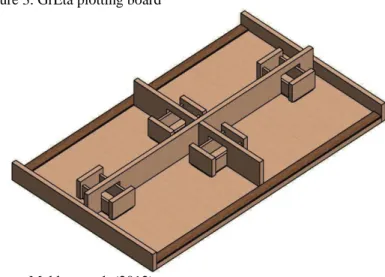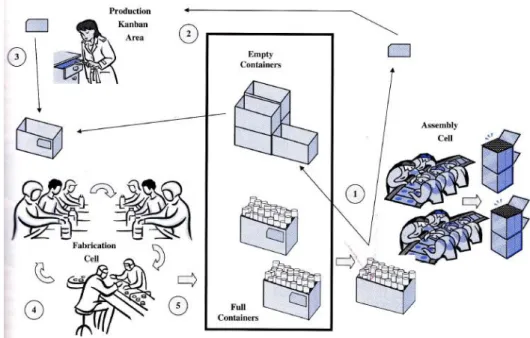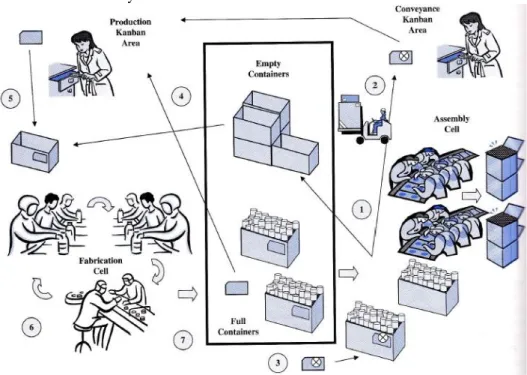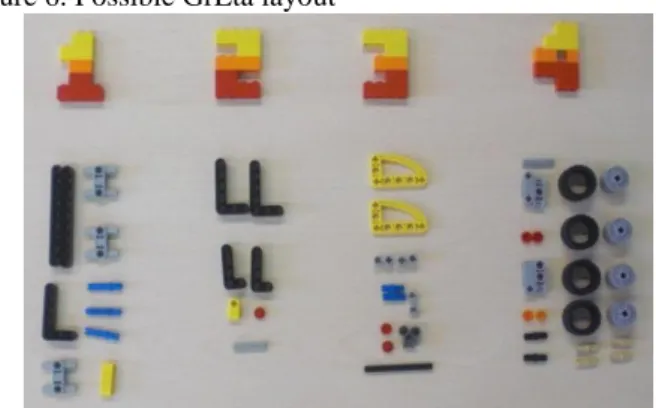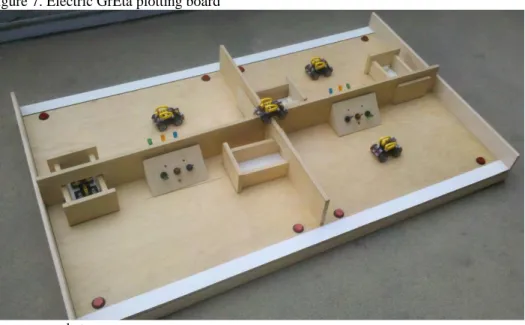IMPLEMENTATION OF A VISUAL KANBAN METHOD FOR PROCESS MANAGEMENT IN THE GRETA ENVIRONMENT
Prof. Lorenzo Ros McDonnell Technical University of Cartagena
Cartagena Spain Phone: +34 968 32 64 78 E-mail: lorenzo.ros@upct.es
Csilla Fejes Széchenyi István University
Győr, Hungary Phone: +36 70 633 9588 E-mail: csilla.fejes.84@gmail.com Katarina Lestyanszka Skurkova, Slovak University of Technology in Bratislava
Trnava, Slovakia Phone: +41 190 7577 754 E-mail: katarina.skurkova@gmail.com
Norina Szander Széchenyi István University
Győr, Hungary Phone: +36 70 426 0730 E-mail: noinya@gmail.com Abstract
GrEta is an innovative simulation project, what was constructed in Szabó-Szoba R&D Laboratory at Széchenyi University Győr, for modelling the nature of flexible production processes. It is one of the best ways to demonstrate the most commonly occurring logistics phenomena in series of mass production on the learning-by-doing way. As the latest development in the GrEta environment we applied the visual kanban method to highlight the difference between push and pull production systems. The GrEta plotting board is also equipped with an automatic time measurement system, to register all the data the participants need to form KPIs, create an adaptable evaluating scheme and support the decision making process. The aim of this paper is to sum up the theory of kanban and to describe how we integrated it into the GrEta plotting board as a new phase of the development of our learning-by-doing training environment.
Keywords: production process modelling, kanban, learning-by-doing, performance evaluation
1. INTRODUCTION
The main challenges of modern logistics and supply chain management are providing high level quality service for customers according to the ever-growing and ever-changing demands, optimizing low series production and distribution in various environments, managing stocks in lean and agile production systems, eliminating the bullwhip effect, applying different trade-off solutions for minimizing infrastructure investment, distribution and warehousing costs and maximizing capacity utilization. The wide variety of products, the challenges of fluctuating demand, the appropriate inventory management and the application of modern production and distribution strategies requires flexible innovative thinking and special management skills from experts: to construct and manage an effective, well-balanced manufacturing and distribution process in supply networks. (Bajor et al.
2011)
The learning-by-doing method, based on personal experience (dialectic approach) is able to help in the education and training to get these innovative and cooperative skills.
The main purpose of our innovative LEGOstics simulation projects is to construct special real-life environments for modelling logistics systems and phenomena (the nature of product and information flow in a supply chain, the meaning of delivery in time shipments, material handling and order picking processes of a warehouse or a factory, flexible manufacturing, work-in-process inventory management, lean thinking, etc). During the learning-by-doing LEGOstics trainings participants can get practical knowledge and develop many innovative skills to be able to construct, design and re-engineer sustainable and efficient logistics processes. They can understand the importance of observations and measurements in logistics, and they feel the responsibility of making decisions (Makkos et al. 2012). In this creative learning environment all the actions are provided by participants – with flexible, dialectic (learning-by-doing) ways, focusing on evaluation results and the whole process of performance measurements.
We are developing all these environments on the same platform: analysing and developing the processes according to the technology and real nature of logistics processes (warehousing, material handling, production and transportation).
After presenting the basic concept of GrEta environment (second chapter) we give a short summary about the theory of kanban, then we are going to describe the integrated developments in the fourth chapter.
2. THE GRETA ENVIRONMENT The GrEta car
GrEta is a self-developed, non-official LEGO product, based on our intention to construct a relatively simple model, which can be built up differently and in totally flexible ways (Figure 1). The result is GrEta (E is a capital letter which represents Eta – efficiency or effectivity).
Figure 1: GrEta car
Source: Makkos et al. (2012)
GrEta car has 8 separate functional parts: chassis, wheels, engine, engine hood, seat, computer unit, cabin, lamps (Figure 2). The parts also can be assembled on some ways. The participants have a lot of possible strategies and production system structures, according to the decisions of the team based on the different personal attributes. (Makkos et al. 2012) Figure 2: GrEta main parts
Source: Makkos et al. (2012)
GrEta plotting board
The plotting board is basically a regular wooden board, which has been separated into four workstations (Figure 3). Between the workstations we situated four drawers for transportation. In the game the transportation has the highest priority, when a box (shipment) comes it always has to be unloaded and sent back to the previous participant to provide the possibility for the continuous material flow. (Szander et al. 2012)
Figure 3. GrEta plotting board
Source: Makkos et al. (2012) 3. KANBAN
The kanban is very popular in nowadays productions, so that we added visual kanban system to the GrEta plotting board to modell this kind of production environment.
Kanban – a signaling system used to trigger upstream order releases in a pull scheduling environment. Typically cards are used as the signaling medium – however, other devices such as plastic markers, balls, or empty containers have been used.
In a kanban system, the flow of materials is controlled using a method by which workstations can exchange signals when one is about to run out of material. By pulling rather than pushing material through the plant, work is produced only as needed. There is no longer the time-bucket constraint and an entire production batch does not need to be completed before material can be transferred to a subsequent workstation. Kanban containers have a size that can be manually transported between workstations permit small quantities of materials to be transferred to the next operation as soon as a container is filled.
Two types of kanban card systems are common – the single-card and the two-card systems. The single-card system, illustrated in Figure 4, works well when two sequential workstations, or manufacturing cells, are in close proximity.
Figure 4. The single-card system
Source: Aikens (2011)
The sequence works as follows.
When the assembly cell empties a container of parts, an operator returns the empty container to the storage area and withdraws a full container.
The kanban card is removed from the container and returned to the production kanban post as a signal to the upstream fabrication cell to produce more parts.
An operator from the fabrication cell will take the card from the production kanban area and withdraw an empty container from the storage area. The card is then attached to the carton.
The fabrication cell completes the order.
When the container is full it is moved, with the card still attached, to the staging area waiting to be withdrawn by the assembly cell.
A two-card system is illustrated in Figure 5 and is necessary when the two sequential operations are not close.
Figure 5 Two-card kanban system
Source: Aikens (2011)
This system uses a conveyance card and a production card. The two-card sequence works as follows.
When the assembly cell starts to work on a container the conveyance card is removed and taken to the conveyance card post, where it is retrieved by a material handler.
The material handler then goes to the storage area where a full kanban container is withdrawn and removes the production card from the container. The handler then replaces it with a conveyance card.
The full container, with conveyance card attached, is then transported to the material staging area in advance of the assembly cell.
The production card is taken to the production post.
The production card is withdrawn by a fabrication cell operator as a signal to produce more parts. The operator withdraws an empty container from the storage area and places the production card on the container.
The fabrication cell then proceeds to fill the order.
When complete, the full container with production card attached is transported to the storage area.
A kanban signal does not have to be a card nor does the signaling medium even have to be written. Any kind of visual signal can suffice. Rolling colored golf balls down a chute, hoisting a flag, or using a semaphore style code can all be effective means for communicating. One simple form of kanban involves painting a square on the floor or taping off a designated area on a workbench between two operators. When material occupies the square the upstream operator does not produce. When the material occupying
the area has been depleted, the upstream operator knows that it is okay to start producing again.
A variation of kanban assigns jobs a priority using a system of distinguishing colors.
For example, if red is used to indicate top priority, operators would be instructed to process red cards ahead of other colours. (Aikens 2011)
4. TRAINING SCENARIO
The GrEta training was constructed for four participants, but it also can be played by eight or more people. as we created a flexible training method. (As an example, for 8 participants we create two groups, like 4 people are sitting and assembling, the rest stay close to observe and measure, then they change positions in every round. It is very effective, because all assembling positions have a worker and an observer, every participant can practice the tasks and also see through the whole process – finally they can get more attractive ideas for process development).
We prepared a step-by-step individual assembling guide for participants, because it is inevitable to have experience in the assembling of all parts and the final model as well. In the instructions guide we separated the assembling tasks into four different steps, which we use later as the first layout in the game.
Figure 6. Possible GrEta layout
Source: Baladincz et al.(2012)
In the following phase participants are situated around the plotting board, and start the assembling with the initial layout in series mode (no parallel working). They are preparing only one model on this sequential way four times, while they change the positions in each round. This way every player gets the experience about each task, and is also able to observe the adequate and the insufficient points in the procedures.
They need to be clear with the rules, which are the following:
The tasks should be performed independently.
No elements exchange between the positions (players have to follow the previously discussed scenario in each round).
Priority of the transportation (unloading and returning the boxes):
Documentation (register every detail which is considered to be relevant).
Quality checking.
Discussing remarks, problems, ideas round-by-round.
Decision about the layout.
After the sequential assembling practice they can start the mass production. They have to choose a boss from the group who will be responsible for the layout, the tasks and the whole process. In the first round of parallel assembling the participants use the basic layout what can be changed after the discussion. The most important part of this round is to declare the performance measurement requirements. They also have to decide what to measure, and how to measure, because this will be the base of the following optimization.
During the training participants can get experience about production teamwork (allocate procedures according to different features of a given workstation – speed, accuracy, quality checking, etc.) and also in process analysis (after a round they discuss their observations, make some changes, do it again, evaluate the consequences, etc.) The main questions are: What is the real meaning of efficiency at a given case? What to measure and how to measure? How to improve capacity utilization? How to fit different processes following each other on the best way? (Baladincz et al. 2012)
The participants do not compete with each other – their job is to improve productivity and provide high-level quality checking at the same time (measurements, quality check points, etc.)
Until the new phase of the development the production worked in push system: if somebody was ready with the task the semi-finished product was forwarded to the next assembler who had to unload the transport box and send it back immediately. At this point they had to choose: start to assemble the elements on the arrived semi-finished product, or get back to the interrupted process.
With the new electric GrEta plotting board we’re also able to simulate the production method in pull system with visual kanban. When a position is ready to receive material they switch a lamp on, signalling to the previous position. In that way the products will arrive in the right time and the assemblers don’t need to interrupt an other process to deal with the arriving shipment. In this way the production can be continuous the participants can work with better circumstances. One relevant difference can be the stockpiling. With the kanban system the stockpiles emerge at a certain position, they can’t just push it to the next participant’s area – one piece they can store in the transport box, but the following pieces must be handled other ways.
Every position has three switches to sign the need of material in both directions. The third one is used for the bulk production, when they need more of the basic elements – when the light is on, the “supplier” who’s not sitting at the table will deliver the matching pieces. The continuous manufacturing is one possible development way for the GrEta plotting board. We also integrated 2-handed idle-time buttons for the detection of inactive periods at each player. At the end it is possible to compare not only the lengths of inactive periods, but the distribution of inactivity in space and time as well. We are using magnets and reed-relays for the monitoring of transport activities. We put a magnet at the bottom of one side of each transport box, and a reed-relay under the box – the logical value is 1 when the magnet is closed to the reed-relay, if it is far the value is 0. It is possible to import the results into a CSV file, where we can easily make graphs, and analysis. The micro- controller and all the wires are situated under the table – so that they won’t disturb the assembly. We can see the Electirc GrEta in the next picture.
Figure 7. Electric GrEta plotting board
Source: own photo
This way the participants can actually experience how do the push-, and pull systems work, the differences, pros and cons of both ways of production processes and they can get a picture about the operations and specialities. Thanks to the automatic time measurement system we can register every data, after the game the participants can see actually theirs and the system’s performance.
5. CONCLUSION
Laboratory of LEGOstics is an innovative (low-cost) learning-by-doing environment for students, experts and researchers from the field of logistics. In the GrEta manufacturing environment all the assembling and re-engineering actions are provided by participants according to the goal: reduce the time request and improve the productivity rate of the mass-production system.
During the training it is possible to highlight the importance of logistics process re- engineering and develop the critical skills of participants to be able to:
recognize the critical factors of production processes
construct appropriate performance measurement systems
support the decision making process of system developments
Adding the kanban feature to the plotting board can be effective in formal education for deeper understanding the theory in learning-by–doing way. The participants can realize in practical environment the impact of changing systems, processes in production systems.
The biggest advantage of using kanban is the automation of replenishment processes;
actually the system can manage itself if the constructed environment is properly built.
As a further research direction we are going to apply the Balanced Scorecard performance measurement system in order to help the participants to understand how they can create a measurement frame for production processes.
6. ACKNOWLEDGEMENT
This research was supported by the European Union and the State of Hungary, co- financed by the European Social Fund in the framework of TÁMOP 4.2.4. A/2-11-1- 2012-0001 ‘National Excellence Program’.
7. REFERENCES
1. P. Bajor, T. Bódis (2011): Quality thinking in LEGOstics Laboratory innovations, in.
Quality2011 Conference Proceedings, pp. 351-356, Neum-BIH 2011. 01st-04th June, 2011.
2. Judit, Makkos-Káldi, Gergely, Hódosi, Sándor, Diószegi, Prof. Lorenzo Ros- McDonnell and Prof. BojanRosi: Applying the LEGOstics concept in formal education at Cartagena University Spain, The International Conference on Logistics &
Sustainable Transport 2012, Celje
3. N. Szander, Z. Makrai, P. Bajor (2012): Development of LEGOstics environments in Szabó-Szoba laboratory, on 2nd International Students Symposium, Bremen-DE, Dec.
2012.
4. C. Harold Aikens (2011): Quality inspired management. The Key to Sustainability.
Prentice Hall, Pearson Education, Inc., New Jersey, ISBN 10: 0-13-119756-8, ISBN 13: 978-0-13-119756-5
5. Emőke Ila, Baladincz; Norina, Szander; Sabrina Trafela; Péter, Bajor - Logistics process re-engineering in the »GrEta« manufacturing environment, Toyotarity in the European culture – the 4th SemIIP – Ustron-Jaszowiec – Poland 07-09.12.2012.
6. H. Jodlbauer (2007): Customer driven production planning, Int. J. Production Economics 111, doi:10.1016/j.ijpe.2007.03.011
7. S. M. Disney, D. R. Towill, W. van delVelde (2003): Variance amplification and the golden ratio in production and iventory control, Int. J. Production Economics 90, doi:10.1016/j.ijpe.2003.10.009
8. Missbauer, H. (2008): Models of transient behaviour of production units to optimize the aggregate material flow, Int. J. Production Economics 118, doi:10.1016/j.ipe.2008.11.014

